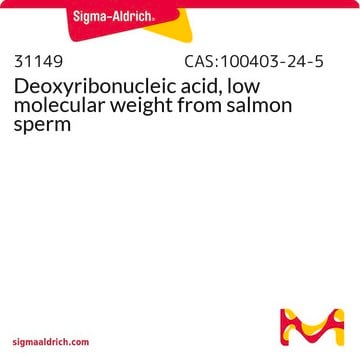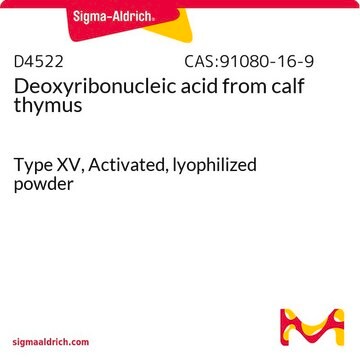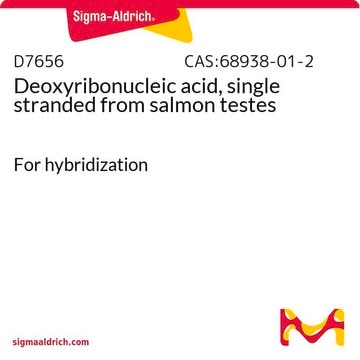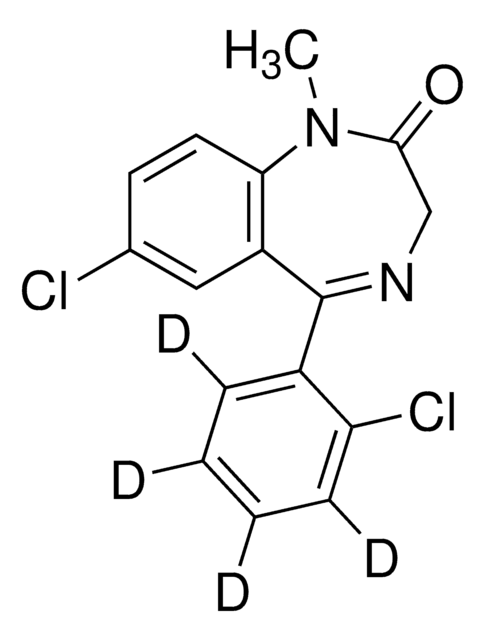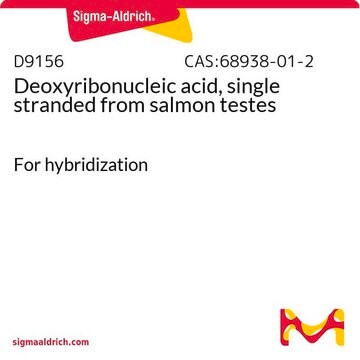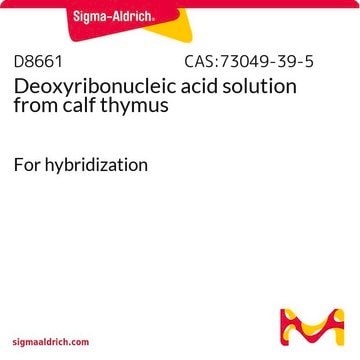D8273
Deoxyribonucleic acid−cellulose single-stranded from calf thymus DNA
lyophilized powder
Synonym(s):
single-stranded DNA-Cellulose, ss-DNA-Cellulose, DNA-Cellulose
Sign Into View Organizational & Contract Pricing
All Photos(3)
About This Item
Recommended Products
form
lyophilized powder
extent of labeling
≥3 mg single-stranded calf thymus DNA/g
storage temp.
−20°C
General description
Deoxyribonucleic acid−cellulose single-stranded from calf thymus DNA, also known as ctDNA is a natural source of DNA designed for DNA binding agent studies. The detection limits of ctDNA are around 2.0ng and linear ranges of light scattering intensity (I(LS)) is 0.05-1.5 mµg.
Application
Deoxyribonucleic acid−cellulose single-stranded from calf thymus DNA is used to study the binding parameters and binding specificity of a variety of proteins, nucleotides, and chemical reagents including anti-cancer agents. It is frequently used in pull-down assays and chromatographic procedures.
Quality
May contain a trace of Tris and EDTA.
Storage Class Code
11 - Combustible Solids
WGK
WGK 3
Flash Point(F)
Not applicable
Flash Point(C)
Not applicable
Personal Protective Equipment
dust mask type N95 (US), Eyeshields, Gloves
Certificates of Analysis (COA)
Search for Certificates of Analysis (COA) by entering the products Lot/Batch Number. Lot and Batch Numbers can be found on a product’s label following the words ‘Lot’ or ‘Batch’.
Already Own This Product?
Find documentation for the products that you have recently purchased in the Document Library.
Customers Also Viewed
A Georgaki et al.
Nucleic acids research, 22(7), 1128-1134 (1994-04-11)
A DNA helicase from calf thymus, called DNA helicase F, copurified with replication protein A through several steps of purification including DEAE-Sephacel, hydroxyapatite and single stranded DNA cellulose. It is finally separated from replication protein A on FPLC Mono Q
Q Hua et al.
Cellular and molecular life sciences : CMLS, 60(2), 413-421 (2003-04-08)
Tau, a major microtubule-associated protein of the neuron, which is known to promote the assembly of and to stabilize microtubules, has also been seen associated with chromatin in neuronal cell lines, but its role in this subcellular compartment is still
D Pisetsky et al.
The Journal of rheumatology, 26(9), 1934-1938 (1999-09-24)
To elucidate the epitope structure to DNA by identifying antigenic determinants on bacterial DNA bound by anti-DNA antibodies from normal human subjects (NHS) and patients with systemic lupus erythematosus (SLE). Sera from NHS and patients with SLE were tested by
T Kuzuhara et al.
Biochemical and biophysical research communications, 362(4), 805-810 (2007-09-04)
Tumor necrosis factor-alpha (TNF-alpha) inducing protein (Tipalpha) is a carcinogenic factor secreted from Helicobacter pylori (H. pylori), mediated through both enhanced expression of TNF-alpha and chemokine genes and activation of nuclear factor-kappaB. Since Tipalpha enters gastric cancer cells, the Tipalpha
X Du et al.
Talanta, 55(1), 93-98 (2008-10-31)
The interaction of histone with nucleic acids was characterized by light-scattering measurement using a common spectrofluorometer. Thereby, a sensitive and convenient method for the determination of nucleic acids was established. At pH 4.5-6.5, the interaction of histone with nucleic acids
Our team of scientists has experience in all areas of research including Life Science, Material Science, Chemical Synthesis, Chromatography, Analytical and many others.
Contact Technical Service